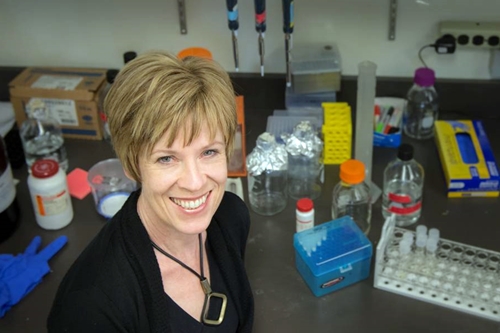10 November 2015. A lab at University of Southern California and biotechnology company developed a technique for editing genomes in blood-forming stem cells as a potential treatment for HIV infection. The team from the lab of USC medical school professor Paula Cannon and Sangamo BioSciences in Richmond, California published its findings yesterday in the journal Nature Biotechnology (paid subscriptions required).
The USC/Sangamo team are seeking more effective techniques to edit genomes in human hematopoietic stem and progenitor cells, or HSPCs, the early-stage cells that transform into blood cells. “Gene therapy using HSPCs has enormous potential for treating HIV and other diseases of the blood and immune systems,” says Cannon in a university statement. “And using genome editing techniques now allows us to make very precise changes that could repair genetic mutations, the gene typos, that can cause disease.
Being able to edit the genes in these blood-forming stem cells makes it possible to deactivate genes that create receptors for viral diseases, such as HIV, as well as immune deficiencies, and blood disorders. But these early-stage cells are also simple and primitive, with few accessible targets for editing.
Cannon’s lab is partnering with Sangamo to adapt the company’s genome-editing technology using zinc-finger nucleases, synthetic enzymes that can modify DNA sequences, including corrections or insertions. These enzymes, with a hydrocarbon and zinc chemistry, branch out in finger-like protrusions that bind with DNA molecules. Sangamo says it engineers the proteins to predictably and consistently bind with longer DNA sequences.
In addition, zinc-finger nucleases need only a brief, temporary expression to perform their editing functions, making them useful for modifying the genomes, but not otherwise damaging the stem cells. The researchers delivered zinc-finger nucleases to the genomes of human blood-forming stem cells with messenger RNA, signaling proteins that send genetic instructions, and electroporation, millisecond electrical pulses creating temporary pores in the cells’ membranes.
The editing enzymes targeted the CCR5 gene that encodes a receptor in T-cells, white blood cells in the immune system, that when damaged allow HIV viruses to enter the host cells. The researchers used adeno-associated viruses to deliver a healthy replacement DNA sequence, along with the gene editing enzymes. Adeno-associated viruses are naturally occurring microbes that can infect cells, but do not integrate with the cell’s genome nor cause disease.
The team found the edited genes succeed in 17 to 26 percent of peripheral blood stem cells and 19 to 43 percent of blood-forming stem cells from the liver, which the researchers say is a high rate of efficiency for these techniques. Results also show the edited stem cells, when transplanted into immune-deficient mice, transform into functioning blood cells while retaining the stem cell edits.
Sangamo Biosciences is also collaborating with University of Pennsylvania medical school in adapting its gene-editing techniques to HIV therapies. As reported last year in Science & Enterprise, a clinical trial shows the company’s gene-editing technology can engineer the immune cells of HIV-positive patients to resist infection and decrease their viral loads.
Read more:
- Gene Editing Boosts Red Blood Cell Output in Lab
- Seattle Children’s, Biotech Collaborate on Gene Editing
- Genome Editing Biotech Gains $70M in Venture Funds
- Trial Shows Engineered T-Cells Act on Multiple Myeloma
- Biotechs Partner on Cancer Stem Cell-Gene Therapies
* * *


 RSS - Posts
RSS - Posts
You must be logged in to post a comment.